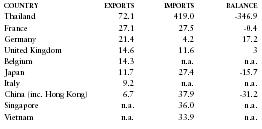Lao People's Democratic Republic - Foreign trade
The political reorganization of 1975 brought changes in Laos's foreign trade pattern, because regional alignments were shifting and because the aid needed to finance the nation's imports was no longer available from the US. In the 1980s, much of the nation's trade was subsidized by the former USSR. The export of electricity, the sale of overflight rights to foreign airlines, wood products, green coffee, and tin are sources of foreign earnings. In 1991 Laos's largest export earner, logging, was banned pending steps to prevent further destruction of the forests. There are 11 million ha of mature forests in Laos, and about 4.4 million are considered commercially exploitable. The ban on log exports was modified to allow the export of already cut logs and logs from stipulated cutting areas. Foreign aid grants exceeded export earnings in 1991. That year, export revenue decreased by 22% from 1990 because of a reduction of timber exports and a decline (caused by drought) in the production of electricity for export. At the same time the cost of imports increased by 62%, owing to the newly adopted free trade measures, which ended restrictions on imported goods.
In 2000, major exports included wood products, garments and textiles, fish, and iron and steel. Major imports include machinery and equipment, vehicles, and fuel.
Principal trading partners in 2000 (in millions of US dollars) were as follows:

| COUNTRY | EXPORTS | IMPORTS | BALANCE |
| Thailand | 72.1 | 419.0 | -346.9 |
| France | 27.1 | 27.5 | -0.4 |
| Germany | 21.4 | 4.2 | 17.2 |
| United Kingdom | 14.6 | 11.6 | 3 |
| Belgium | 14.3 | n.a. | n.a. |
| Japan | 11.7 | 27.4 | -15.7 |
| Italy | 9.2 | n.a. | n.a. |
| China (inc. Hong Kong) | 6.7 | 37.9 | -31.2 |
| Singapore | n.a. | 36.0 | n.a. |
| Vietnam | n.a. | 33.9 | n.a. |
Comment about this article, ask questions, or add new information about this topic: